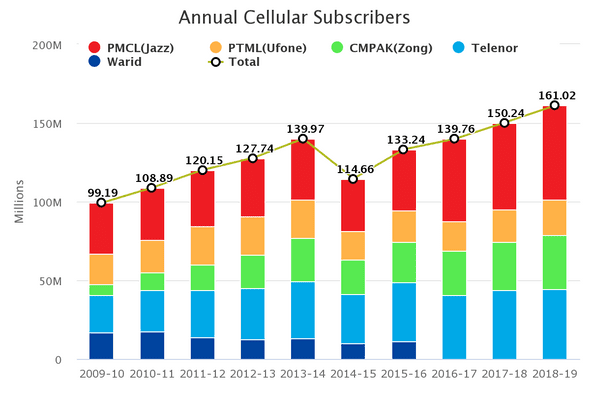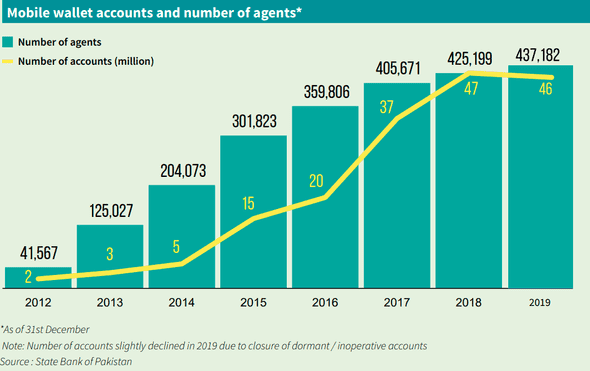Digital landscape in Pakistan
July 12, 2020 - 5 min read
This article assumes Pakistan’s population at 217M people, which is extrapolated from World Bank’s Pakistan population figure of 216.6M as of 2019
Additionally, the currency conversion used in this article uses an exchange rate of USD 1 = PKR 166.13 on 2020-07-11 - which makes the PKR-USD conversions only approximate
According to Pakistan Telecommunication Authority’s (PTA) Telecom indicators:
-
There are 166.4M telecom subscribers in Pakistan as of May 2020. This corresponds to 76.7 % of the population having access to cell phone subscriptions

- A study conducted by LIRNEasia, a Colombo based think tank, in December 2017 reported the number at 58 % as compared to Pakistan Telecommunication Authority’s number of 72 % back then. The difference lies in that while PTA considers the raw number of SIM cards issued, LIRNEasia considers multiple SIM cards per person as a single subscription.
Reference: Business Recorder (Accessed 2020-07-11)
-
There are 81.9M broadband subscribers as of May 2020, which corresponds to 37.7 % of the population
- An estimate of the telecom sector’s revenue for 2018-2019 is PKR 552.8B/USD 3.3B

- The telecom sector contributed PKR 102.4B/USD 616.4M to the national exchequer for 2018-2019

Some figures from PTA’s annual report for 2019
The report (Accessed 2020-07-11) contains key information about Pakistan’s digital landscape
- International Telecommunication Union (ITU) estimates that 3.9B people or 51.2 % of the global population had internet access at the end of 2018 (Unrelated to the data below)
-
A 29 % increase in 4G device registration in 2019 in Pakistan
- The number is expected to double in 2020
- Price for mobile broadband averaged at PKR 60/GB/USD 0.36/GB
-
Mobile device registrations in 2019:
-
Mobile data traffic:
- 1.75 Gb/user/month in 2018
- 0.36 Gb/user/month in 2016
-
Successful tests for 5G have been conducted in Pakistan by Zong and Jazz
- Pilots are planned
- PTA is of the view that taxes on telecom sector should be lowered to encourage investment and expedite development of new technologis
Services in Azad Jammu and Kashmir (AJK) and Gilgit Baltistan (GB)
- All four mobile operators (Jazz, Telenor, Zong, Ufone) and the Special Communications Organization (SCO) provide fixed line and cellular services in AJK and GB
- Total teledensity as of 2018-2019 is at 70 %

-
Fixed broadband penetration in AJK and GB is really low at 19338 people as of 2019, only 0.36 % of the population

-
SCO is expected to deploy Fiber to the Home (FTTH) in 2020
- Phase 1 targets 36000 subscribers
- Phase 2 targets 40000 subscribers
-
- SCO also provides mobile broadband services, but figures for that are not available
-
Mobile broadband numbers are expected to increase once all cellular operators start providing the service
- The apparent bottleneck the delay (of several years) in the spectrum auction for AJK and GB
Social Media
 Shouldn’t the numbers add up to 100 %?
Shouldn’t the numbers add up to 100 %?
Financial services
- By 2015, only 16 % of the adult population had a bank account
-
46.1M mobile banking accounts
- Out of which 24.5M (53 %) were active accounts as of December 2019
- PKR 28.8B in deposits as of 201912
-
A network of 0.44M mobile banking agents
- 3.6M (1.3B annual) daily transactions
- PKR 12.3B/USD 74M worth of daily transactions (Annual:PKR 4.5T/USD 27.1B)

-
Target for 2023: 65M active mobile wallets
- Of which 20M to be owned by women
Further reading
While, I haven’t gone through these myself yet, these resources contain relevant and useful information and are on my reading list:
- Hootsuite’s Digital 2020: Pakistan report by Simon Kemp
-
Digital Ctizenship in Pakistan report from 2015 by British Council Pakistan to get a more fine-grained idea of demographics of internet use. It’s a bit outdated (2015) and there have been significant increases in all numbers since then, but it gives a rough trend of the demograpics of internet use. Ror example, it contains
-
Pakistan- progressing towards a fully fledged digital economy by GSMA from June 2020
- This report contains quite different figures from the ones quoted in this, which are mainly taken from Pakistan Telecommunication Authority’s website and 2019 report







